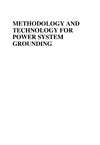Grounding is the fundamental measures to ensure the safe operation of power systems, including power apparatus and control/monitoring systems, and guarantee the personal safety. Grounding technology is an interdiscipline involving electrical engineering, high voltage technology, electric safety, electromagnetics, numerical analysis, and geological exploration
Methodology and Technology for Power System Grounding:
- Covers all topics related to power system grounding
- Presents fundaments and theories of grounding systems
- Well balances technology and methodology related to grounding system design
- Helps to understand the grounding analysis softwares
- Highlights the advanced research works in the field of grounding systems
- Comprehensively introduces numerical analysis methods
- Discovers impulse ionization phenomenon of soil around the grounding conductors
- Touches on lightning impulse characteristics of grounding devices for towers and buildings
As a comprehensive treatment of the topic, Methodology and Technology for Power System Grounding is ideal for engineers and researchers in power system, lightning protection, and grounding. The book will also better equip postgraduates, senior undergraduate students in electrical engineering.
Content:
Chapter 1 Fundamental Concepts of Grounding (pages 1–26):
Chapter 2 Current Field in the Earth (pages 27–79):
Chapter 3 Measurement and Modeling of Soil Resistivity (pages 81–129):
Chapter 4 Numerical Analysis Method of Grounding (pages 131–189):
Chapter 5 Ground Fault Current of a Substation (pages 191–222):
Chapter 6 Grounding System for Substations (pages 223–273):
Chapter 7 Grounding of Transmission and Distribution Lines (pages 275–302):
Chapter 8 Impulse Characteristics of Grounding Devices (pages 303–390):
Chapter 9 DC Ground Electrode (pages 391–460):
Chapter 10 Materials for Grounding (pages 461–498):
Chapter 11 Measurement of Grounding (pages 499–551):
 |
|
О проекте
|
|
О проекте


